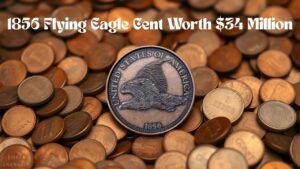1943-D Bronze Lincoln Cent: An Error Turned Into A Legacy Worth Millions
There are severa surprising stories inside the global of coin collecting, but the tale of the 1943-D Bronze Lincoln Cent is surely appalling. It’s no longer a penny but a historical mistakes worth more than a bit over one crore rupees. Sounds like a film plot, but the coin is actual—and really rare.
Let’s see what is so particular approximately this copper-seems-like coin, a way to spot counterfeit coins, and may you possess this sort of coin as nicely?
The story behind: How did this historical mistake happen

In the year 1943, there has been a big alteration in the coins of the USA. That year, World War II changed into underway, and copper became in amazing demand for the materials employed within the conflict. Thus, at some stage in that yr, the U.S. Mint produced more or less one thousand million Lincoln cents product of zinc-lined steel in place of copper. The cash were silvery in look and magnetic, completely different.
But the Denver Mint erred. A few of their antique copper planchets dating lower back to 1942 have been mistakenly included within the 1943 steel cash and were marked 1943-D.
Thus changed into created the 1943-D bronze cent, an unintentional mistakes that grew to become out to be one of the world’s most expensive coins.
How rare is this coin?
Extremely rare. It is estimated by experts that there are only one or two remaining original 1943-D bronzes in the world. The coin has been called a “treasure of the coin world” because it did not have a right to exist. And for this reason, maybe, its price and popularity are as great as they are.
How much is it worth?
In 2021, a Mint State 64 (MS64) grading edition of this coin was sold for \$840,000 (approximately Rs 7 crore). Even if it is slightly in poor condition, it can be sold for lakhs.
Because this coin:
- It is rare
- It is minted by error (mint error)
- And It is highly appealing to collectors
That’s why both its demand and price are highly high.
How to determine if you have a genuine 1943-D bronze cent?

If you have a 1943 copper-looking coin, try this easy test first:
- Magnet test:
- If the coin adheres to a magnet, it is metallic, a ordinary, regular coin.
- If it would not adhere to a magnet, it could be bronze (copper-based).
- Check for the mint mark:
- There need to be a tiny “D” underneath the 1943 date, showing it became from the Denver Mint.
- If the “D” is substituted by an “S” or nothing, it is now not the real article.
But watch out: a few do copper-coat 1943 steel cash to create faux coins, so this take a look at is handiest the first stage.
Are there counterfeit coins?
Yes, and in abundance. Con artists might:
- Use 1948-D coins and replace 8 with 3
- Or plate steel coins with copper so they appear to be the real thing.
Others are so good they are almost impossible for most people to recognize as fake.
So if you think you have one:
- Don’t clean it,
- Don’t attempt to analyze it yourself,
- Have it graded by a professional service such as PCGS or NGC.
These firms will authenticate the coin by checking its metal composition, weight, design and print details.
Conclusion: Do you have a treasure worth millions?
The 1943-D Bronze Lincoln Cent is not an everyday coin. This is a piece of history, which was accidentally made and is now possessed by a very limited number of individuals around the world. If you possess a 1943 copper coin, which is not attracted to a magnet and features a “D” mint mark on it—do not consider selling it in an auction immediately! Have it evaluated by a professional first.
That old coin you have kept in your drawer at home can make you a millionaire.
FAQs
What is the 1943-D Bronze Lincoln Cent?
A rare mint error where a bronze planchet was accidentally used instead of steel at the Denver Mint in 1943.
Why did the U.S. Mint stop using copper in 1943?
Copper was needed for World War II efforts, so the Mint used zinc-coated steel to produce pennies that year.
How rare is the 1943-D Bronze Penny?
Extremely rare—only one or two confirmed examples exist, making it one of the rarest U.S. coins ever produced.


